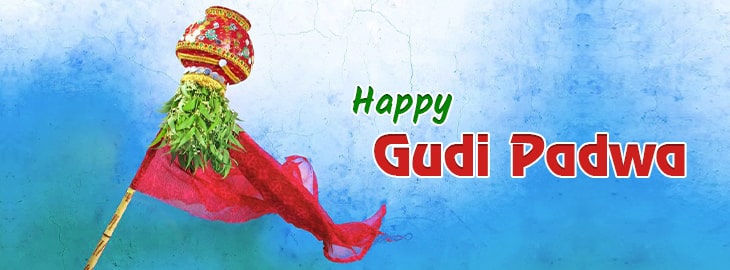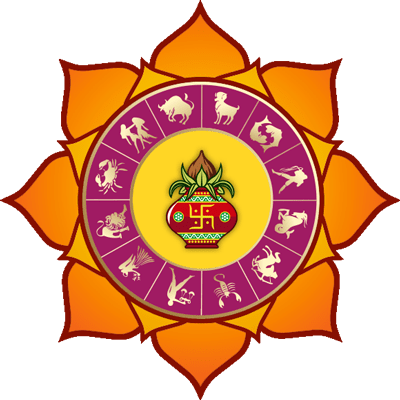
Gudi Padwa
Get Gudi Padwa 2024 date for New Delhi, India. Gudi Padva is celebrated as Hindu New Year in Maharashtra. It is known as Samvatsar Padvo, Ugadi, etc. in other regions of India.
Gudi Padwa 2024
When is Gudi Padwa in 2024?
Tue
09th
Apr
Gudi Padva Muhurat For New Delhi, India
Marathi Vikram Samvat 2081 Begins
Pratipada Tithi Begins at 23:52:35 on April 8, 2024
Pratipada Tithi Ends at 20:33:09 on April 9, 2024
Gudhi Padwa is the Marathi festival, which is famous because Hindu New Year (known as “Samvatsara” in Sanskrit) begins from this day. As per the Panchang, Nav Samvatsar begins from the Pratipada of Shukla Paksha (bright fortnight) of Chaitra month.
Gudhipadwa Muhurat
- The Samvatsara begins on the day when Pratipada (1st day of a fortnight; also known as “Padwa”) is prevalent during the sunrise.
- If Pratipada is prevailing on the sunrises of 2 days, the 1st day is considered for the festivity.
- If Pratipada is not prevalent during the sunrise of any day, Nav Varsh will be celebrated on the day when Pratipada is starting and ending.
In case of Adhik Maas (extra month added after every 32 months, 16 days, and 8 Ghante), below given rules will be followed:
If it is Chaitra Adhik Maas (the extra month), Nav Samvatsar will start from its Pratipada only. It is because Adhik Maas is the part of its real month only. Hence, along with the real Chaitra month, Adhika Chaitra is also considering the part of the New Year.
When to Perform Gudi Padwa Rituals
Below given things can only be performed during the original Chaitra month:
- Nav Varsh Phal Shravan (listening to the New Year’s horoscope)
- Taila Abhyang (oil bath)
- Navratrarambh (beginning of Chaitra Navratri)
- Nimba Patra Prashan (eating Neem leaves)
- Ghatsthapana (establishing Kalash/holy stoup for Navratri Puja)
- Dhwajaropan (flag hoisting)
But, Nava Varsha Naam grahan (naming rite of the New Year) during resolved must be done in Adhik Chaitra Shukla Pratipada only. The name of this Samvatsara is Ānanda 2078. It is also the Shri Shalivahan Shak 1943 and the name of this Samvat is Plava.
King of Nav Samvatsara (Varshesh)
Lord (astrological planet) of the 1st day of the New Year is considering as the Lord of the year. In 2021, the Hindu Nav Varsh day is Tuesday. Hence, lord of the Hindu Nav Varsh (New Year) 2021 is mars.
Gudhi Padwa Mantras
These Mantras can be chanted as per the significance of your worship procedures. Some people keep fast on the day.
Mantras for them as well are given below:
Morning Vrat Sankalp:
ॐ विष्णुः विष्णुः विष्णुः, अद्य ब्रह्मणो वयसः परार्धे श्रीश्वेतवाराहकल्पे जम्बूद्वीपे भारतवर्षे अमुकनामसंवत्सरे चैत्रशुक्ल प्रतिपदि अमुकवासरे अमुकगोत्रः अमुकनामाऽहं प्रारभमाणस्य नववर्षस्यास्य प्रथमदिवसे विश्वसृजः श्रीब्रह्मणः प्रसादाय व्रतं करिष्ये।
Shodashopachara Pooja Sankalp:
ॐ विष्णुः विष्णुः विष्णुः, अद्य ब्रह्मणो वयसः परार्धे श्रीश्वेतवाराहकल्पे जम्बूद्वीपे भारतवर्षे अमुकनामसंवत्सरे चैत्रशुक्ल प्रतिपदि अमुकवासरे अमुकगोत्रः अमुकनामाऽहं प्रारभमाणस्य नववर्षस्यास्य प्रथमदिवसे विश्वसृजो भगवतः श्रीब्रह्मणः षोडशोपचारैः पूजनं करिष्ये।
After Pooja, the fasting person must chant this Mantra:
ॐ चतुर्भिर्वदनैः वेदान् चतुरो भावयन् शुभान्।
ब्रह्मा मे जगतां स्रष्टा हृदये शाश्वतं वसेत्।।
Gudhi Padwa Celebrations
- In the morning, after doing the daily works like cleaning, bathing, etc., Gudi is hoisted.
- People clean their houses; and in villages, houses are lepta with fresh cow-dung.
- It is described in the Shastras that Taila Abhyang must be done during the Arunodaya Kaal on this day.
- Gudhi must be worshiped just after the sunrise. It must not be late. - Beautiful Rangoli designs are also made with bright and different colors and houses are decorated with beautiful fresh flowers.
- People wear in new, beautiful clothes. Usually, Marathi women adorn themselves in Kastha or Nauvari (Nine-yard Saree tucked at the back) and men wear Kurta Pajama along with a turban, which is mostly saffron or red.
- Families forgather and greet the New Year to everyone.
- New Year’s horoscope must also be heard on this day.
- Traditionally, the celebration begins after having the sweetened Neem leaves as Prasad. Usually, a paste is made with Neem leaves, jaggery, tamarind, etc. It is believed that this paste purify the blood and increases resistance. Taste of this paste signifies the course of life as sweet, sour, and bitter.
- Delicacies are cooked like Shrikhand, Puran Poli, Kheer (sweet porridge kind of dessert usually made with sweet potato, coconut milk, jaggery, rice flour, etc. by Marathi’s), and Sanna.
- Later in the evening, Lezim is performed by the people.
How to Raise Gudhi
- The area must be cleaned properly where the Gudi will be placed.
- A Swastika should be making on the ground below the Gudhi.
About Gudhi Padwa
Gudi Padva has several names as per the different regions in India.
- Samvatsar Padwa is celebrated among Konkani’s of Goa and Kerala.
- Rest of the Konkani Diaspora in Karnataka knows it as Ugadi.
- People from Andhra Pradesh and Telangana celebrate Ugadi.
- Kashmir is celebrating it as Navreh.
- Sajibu Nongma Pānba or Meetei Cheiraoba is famous in Manipur.
- Chaitra Navratri begins from this day for North Indians.
On this day, Marathi’s hoist the Gudhi. That is why this festival is known as Gudi Padwa. Gudhi is made on a bamboo stick by placing an inverted Kalash of silver, copper, or bronze over it and adorning the bamboo with a good-looking cloth (usually, it is of saffron color and made of silk with brocaded borders). The Gudhi is then adorned with Gaathi (sugar crystals garland), Neem leaves, a mango twig, and red-flower garland.
The Gudhi is hoisted at a higher place like terrace in home so that it is quite visible to everybody. Many people also stick it on their windows or the right side of their doors.
Importance of the Gudhi Padwa
Many beliefs are associated with Gudhi Padwa. Some of them are mentioned below:
- People hoisted Gudi in history when their King Shalivahana defeated Sakas and came back to Paithan, as it is considered as the symbol of victory.
- Some people also hoist Gudhi to commemorate the victory of Chhatrapati Shivaji.
- As it is assumed by some that Lord Brahma produced the universe on this day, Gudi is also believed to be the Brahma Dhwaj (Lord Brahma’s flag). Some people also consider it as Indra Dhwaj (flag of Lord Indra). Hence, for some, it is also the starting of the spring season.
- Some people also hoist Gudi as the symbol of the Lord Rama’s return to the Ayodhya after 14 years of exile.
- Usually, it is believed that hoisting Gudi brings wealth in life.
- Gudhi is also known as Dharma Dhwaj to many and its each part has a meaning. The inverted pot is considered as the head and stick is considered to be spine (as bamboo has the vertebrae, just like human spine).
- For farmers, Gudhipadwa is celebrated as the end of Rabi crop season and the starting of the new crop season. They plough their fields on this day to ensure a good harvest throughout the year.
- Gudipadawa is one of the most favorable Sadhe Teen Muhurats (3 and a half most lucky days) of Hindus. These Sade Teen Muhurats are Chaitra Shukla Pratipada (Gudi Padwa), Vaishakha Shukla Tritiya (Akshaya Tritiya), Ashwin Shukla Dashami (Dussehra), and half Muhurat is considered on Kartik Shukla Pratipada (Diwali). Being quite auspicious, many people start new ventures and investments on this day.



